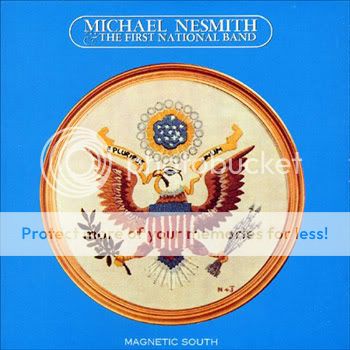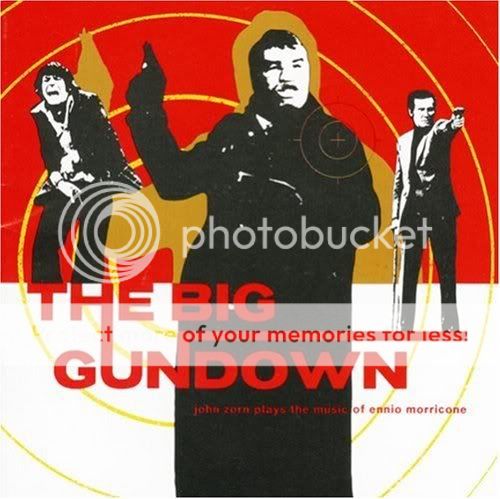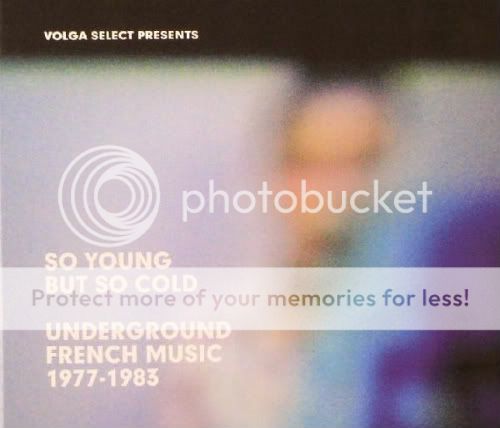
Faust made (er, makes) pretty, catchy, slightly disturbing noise. In their early 1970s heyday, they recorded versions of pop, psychedelia, tape, and electronic music-- but really, they just played Faust music, alienating their record labels, each other, and generally being impossible to either classify or market. By 1974, categorization threatened to ruin the reception of their fourth LP-- long considered their "sell out" record by die-hard fans due to an alleged concession to more palatable songs and mixes-- but as the concept of pretty/catchy noise isn't necessarily as wtf now as it would have been then, the record's rep has mostly recouped. And I guess that's the lesson of Faust: Make the music you want to make, take the drugs you want to take, escape from the outside world when you can, and for god's sake, BE PRETTY/CATCHY/DISTURBING.
IV was Faust's second release for Richard Branson's fledgling Virgin Records. The band had recently been dropped by Polydor, and though Branson wasn't willing to pay them the huge advance sum manager/svengali/credit-taker Uwe Nettelbeck had nabbed from their previous label, he would let the band use Virgin's state-of-74 recording studios at the Manor in Oxfordshire to cut a new album. Faust left Germany for England, played a few shows, and even managed to compile the super-classic The Faust Tapes for Virgin-- with which they promptly guerilla attacked the UK charts by selling it for half a pound-- all before starting work on what would become IV. They even shared studio space with a young Mike Oldfield, whose Tubular Bells would soon help bankroll Virgin into Really Important Label status.
Of course, before the album was done, things got messy: Nettelbeck stepped in to compile the record from Faust's sessions at the Manor (and previous ones in Wümme, Germany) without consulting the band, in turn prompting founding members Hans-Joachim Irmler and Rudolf Sosna to quit. This then forced those who remained-- Jean-Herve Peron, Zappi Diermaier, and Gunter Wüstoff-- to recruit members of Slapp Happy and Guru Guru to fill out their touring band in order to promote IV. By 1975, the band cut (or were relieved of) its ties with Branson and Virgin, reconvened to record a few tracks at Giorgio Moroder's Munich studios for an album that was never completed, and eventually, unceremoniously dissolved. Not much was heard from the Faust camp before the band reunited (sans a couple of members) in 1990, and released Rien in 1994.
So, do you know Faust yet? As an album, IV matches the band's trajectory: Jumbled, fragmented, with random data integrity issues, but seeming more the brainchild of inspired pop anarchists than calculating avant-gardists. Yes, the record sounds more "professional" than any of their others, but somehow that doesn't actually equate to slick sounds: Opener "Krautrock" (which Irmler says was inspired by the band's perception of the British still fearing the "krauts") is on the noisiest end of Faust's spectrum, using distortion and feedback as springboards for tripping into galactic clouds. For better than seven minutes, minute gradients of angelic, overdriven major-chord-sheets are exploited by who knows what devices before the drums come in and the track moves from milky, third-ear noise into MINDFUCKING KRAUTROCK. And before you can explode from the sonic congestion, "The Sad Skinhead" starts, replete with ridiculous 60s go-go beat and skank guitar. They sing, "Apart from all the bad times you gave me, I always felt good with you," "Going places, smashing faces-- what else could have happened to us?" I say needlessly: it's a jam. And then they keep going.
The gorgeous psych-ballad "Jennifer" provides a suitably jarring transition from the previous song, and is further proof that the band (Sosna in this case) were capable of writing actual "songs," with melodies and chords that in some other, non-acid-baked circumstance, might already have been attached to a Volkswagen ad by now. The pulsating bass drone, backed by eerily distant organ and guitar arpeggios, provides the perfect, glowing backdrop for lines like "Jennifer, your red hair is burning," but this song is a good example of how dissecting individual Faustian innards often yields much less than the whole-- it's the sum shine that matters.
"Just a Second (Starts Like That!)" begins as a relatively conventional guitar jam, but soon devolves into electro-noise that reminds me of some of the space-tropical music on Hosono & Yokoo's Cochin Moon-- but the fractured nature of the piece is pure Faust. They go one better on the next track. Right down to the fucked-up tracklisting (which double-confusingly appends names of forthcoming tracks to the previous one), the medley of "Giggy Smile" and "Picnic on a Frozen River" may be the ultimate Faust moment, crossing strains of rock otherwise totally, transitionally opposed-- in this case, fake blues-rock and synthy surf-pop-- in the name of "why the fuck not?" And to no fan's surprise, it is also a magic song.
So is "Läuft...Heißt Das Es Läuft Oder Es Kommt Bald...Läuft". Appearing later on the 71 Minutes compilation as "Psalter", it fits in perfectly on IV: the first half of the song is based on a finger-picked acoustic guitar figure (playing what sounds like 6/4 + 7/4, or hey, maybe 13/4), but adds layers of drums, handclaps, flutes and what sounds like a bowed string (?) of some kind. In any case, what sounds complicated actually comes out pretty lovely, and certainly the most hummable song in 13 that I know. The song ends on a solemn, almost distractingly plain-faced organ postlude. Even with distortion cranked up in the final minute, this is the kind of thing they should be playing in church to fool me into going.
IV ends perfectly with Peron's "It's A Bit of a Pain". This is essentially a strange take on pleasantly psychedelic, 70s So Cal country-rock, but its true awesomeness can only be appreciated by following the lyrical narrative:
It's a bit of a pain
To be where I am.
It's a bit of a pain
To be where I am.
But it's all ri-- BBBBBBZZZZZZZZZZZZZZZZZZZZZZZZZZZZZZZZZZZZZZZZ
This reissue includes a bonus disc of tracks from a 1973 Peel Session broadcast, as well as alternate versions of several songs and fragments. Fans will know the Peel Session songs (the jazzy, sax-heavy "The Lurcher", a "Krautrock" remix and "Do So") from the BBC Sessions+ CD, also contained in 2000's Wümme Years box set. The spacey, ambient piano piece, titled appropriately "Piano Piece", later appeared on 71 Minutes as "Das Meer". Since both discs are available in the box, I'd advise anyone in love with IV and needing more Faust just to drop the required funds and own almost everything Faust released in their original incarnation. Of course, IV isn't in that box, so if you don't need everything, but are curious, it's an easy starting point. Pretty, catchy, slightly disturbing, magic.
-pitchforkmedia.com
DOWNLOAD:Faust-FAUST IV (1974)320kbps

















































